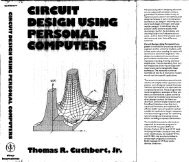Timekeeping in the Electronic Century
Timekeeping in the Electronic Century
Timekeeping in the Electronic Century
You also want an ePaper? Increase the reach of your titles
YUMPU automatically turns print PDFs into web optimized ePapers that Google loves.
with digital watches. Some compla<strong>in</strong>ts had to do with poor quality and design. LEDs<br />
couldn’t be read <strong>in</strong> sunlight, liquid crystal displays (LCDs) were <strong>in</strong>visible at night.<br />
Batteries were annoy<strong>in</strong>gly short-lived. Sett<strong>in</strong>g <strong>the</strong> new watches was always complicated,<br />
often required extra tools, and sometimes seemed downright impossible. Really cheap<br />
watches just stopped runn<strong>in</strong>g entirely.<br />
Whatever <strong>the</strong> reason, buyers returned malfunction<strong>in</strong>g watches to <strong>the</strong>ir<br />
manufacturers <strong>in</strong> record numbers. Manufacturers heard <strong>the</strong>se compla<strong>in</strong>ts, made changes,<br />
and gave consumers an important role <strong>in</strong> shap<strong>in</strong>g <strong>the</strong> form and function of quartz<br />
watches.<br />
But consumer concerns went beyond dreadful quality and design. People began to<br />
question <strong>the</strong> very nature of digital time itself, enough to provoke some academic studies,<br />
even. 12<br />
A common compla<strong>in</strong>t criticized <strong>the</strong> digital display because it was too accurate.<br />
The language of time-tell<strong>in</strong>g, long ago established through read<strong>in</strong>g analog dials, is<br />
<strong>in</strong>exact. When faced with <strong>the</strong> question “what time is it?” <strong>the</strong> analog-dial user may say<br />
“about quarter ‘til eight.” Ask someone who wears a digital watch, though, and <strong>the</strong><br />
answer is “7:43.” As Good Housekeep<strong>in</strong>g magaz<strong>in</strong>e noted <strong>in</strong> its 1976 consumer guide,<br />
“Whe<strong>the</strong>r or not we ord<strong>in</strong>ary mortals need such accuracy is a debatable po<strong>in</strong>t.” 13<br />
After<br />
more than a century of advertis<strong>in</strong>g watches on <strong>the</strong> basis of accuracy, manufacturers of<br />
f<strong>in</strong>e watches had f<strong>in</strong>ally exceeded consumer expectations. 14<br />
By <strong>the</strong> late 1970s resistance to digital watches <strong>in</strong> <strong>the</strong> classroom eventually<br />
subsided. It became clear that digital displays weren’t go<strong>in</strong>g to disappear, and that<br />
noth<strong>in</strong>g cataclysmic had happened because digital expressions of time coexisted with<br />
analog. The fear that digital watches would make <strong>the</strong> analog dial ext<strong>in</strong>ct turned out to be<br />
____________________<br />
Bletchley talk June 2004<br />
page 10

















